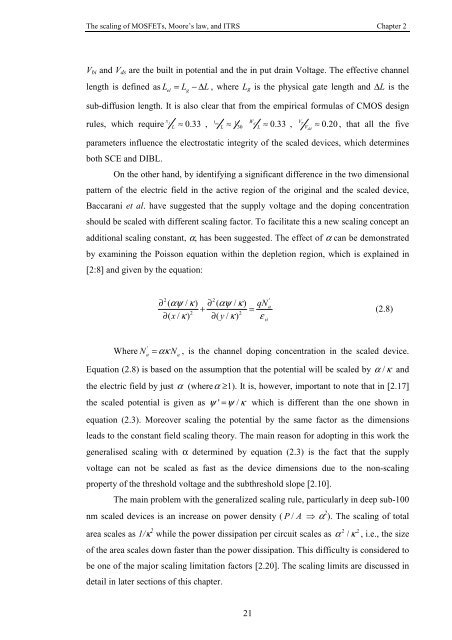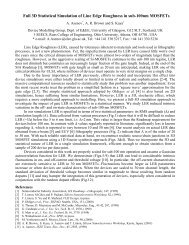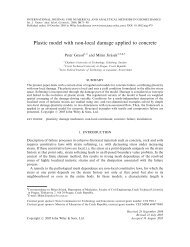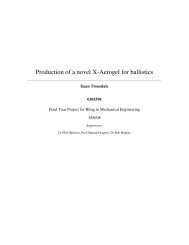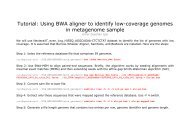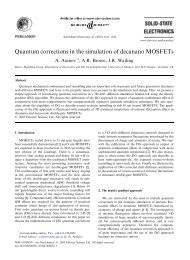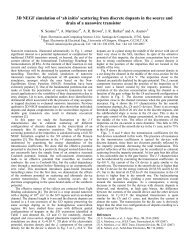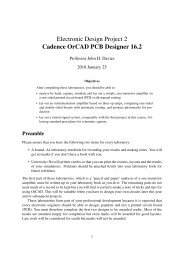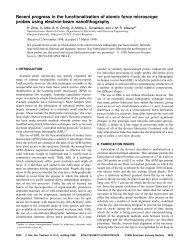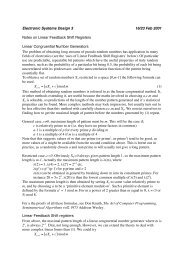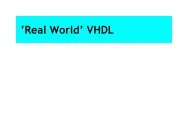2 The scaling of MOSFETs, Moore's law, and ITRS
2 The scaling of MOSFETs, Moore's law, and ITRS
2 The scaling of MOSFETs, Moore's law, and ITRS
You also want an ePaper? Increase the reach of your titles
YUMPU automatically turns print PDFs into web optimized ePapers that Google loves.
<strong>The</strong> <strong>scaling</strong> <strong>of</strong> <strong>MOSFETs</strong>, Moore’s <strong>law</strong>, <strong>and</strong> <strong>ITRS</strong> Chapter 2V bi <strong>and</strong> V ds are the built in potential <strong>and</strong> the in put drain Voltage. <strong>The</strong> effective channellength is defined as L el= L g− ∆ L , where L g is the physical gate length <strong>and</strong> ∆L is thesub-diffusion length. It is also clear that from the empirical formulas <strong>of</strong> CMOS designxrules, which requirejtL ≈ 0.33 , ox 1 WL ≈ dVT30 L ≈ 0.33 , V ≈ 0.20 , that all the fiveparameters influence the electrostatic integrity <strong>of</strong> the scaled devices, which determinesboth SCE <strong>and</strong> DIBL.On the other h<strong>and</strong>, by identifying a significant difference in the two dimensionalpattern <strong>of</strong> the electric field in the active region <strong>of</strong> the original <strong>and</strong> the scaled device,Baccarani et al. have suggested that the supply voltage <strong>and</strong> the doping concentrationshould be scaled with different <strong>scaling</strong> factor. To facilitate this a new <strong>scaling</strong> concept anadditional <strong>scaling</strong> constant, α, has been suggested. <strong>The</strong> effect <strong>of</strong> α can be demonstratedby examining the Poisson equation within the depletion region, which is explained in[2:8] <strong>and</strong> given by the equation:dd∂ ( αψ / κ) ∂ ( αψ / κ)qN2 2'a+ =2 2∂( x / κ ) ∂( y / κ)εsi(2.8)Where N'a= ακ N , is the channel doping concentration in the scaled device.aEquation (2.8) is based on the assumption that the potential will be scaled by α / κ <strong>and</strong>the electric field by just α (whereα ≥1). It is, however, important to note that in [2.17]the scaled potential is given as ψ ' = ψ / κ which is different than the one shown inequation (2.3). Moreover <strong>scaling</strong> the potential by the same factor as the dimensionsleads to the constant field <strong>scaling</strong> theory. <strong>The</strong> main reason for adopting in this work thegeneralised <strong>scaling</strong> with α determined by equation (2.3) is the fact that the supplyvoltage can not be scaled as fast as the device dimensions due to the non-<strong>scaling</strong>property <strong>of</strong> the threshold voltage <strong>and</strong> the subthreshold slope [2.10].<strong>The</strong> main problem with the generalized <strong>scaling</strong> rule, particularly in deep sub-100nm scaled devices is an increase on power density ( P / A ⇒ α 2 ). <strong>The</strong> <strong>scaling</strong> <strong>of</strong> totalarea scales as 1/κ 2 2 2while the power dissipation per circuit scales as α / κ , i.e., the size<strong>of</strong> the area scales down faster than the power dissipation. This difficulty is considered tobe one <strong>of</strong> the major <strong>scaling</strong> limitation factors [2.20]. <strong>The</strong> <strong>scaling</strong> limits are discussed indetail in later sections <strong>of</strong> this chapter.21


